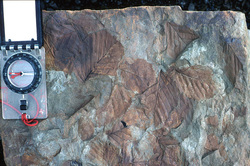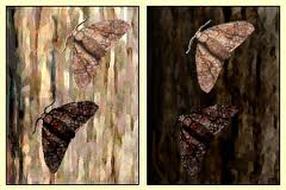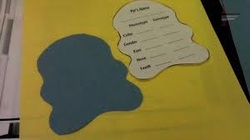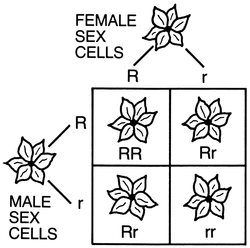 What are Temperate Climate Plant Fossils? Well, that is a very good question. To start off, Temperate Climate or Tepid Latitudes of the world lie in between the polar and tropics circles. The changes in regions like these during the time period of summer through winter are usually moderate, instead of extremely hot or cold.
Now, the plant fossils from Antartica come into this blog post because they are usually what freeze and turn into fossils when the weather gets too cold. As you can see, in the picture to the left, the plants freeze together to form a fossil.
 As you all know, Darwin had a great theory that of natural selection. He had many theories actually, but his final theory made many great discoveries. It helped many of the scientists today realize things they hadn't realized before. His greatest theory was on natural selection.
Natural selection as you know is the process where organisms better adapted to their environment tend to survive and produce more offspring than other organisms. In his theory about natural selection, he stated many things about evolution. Evolution is the process which different kinds f living organisms are thought to have developed and diversified from earlier forms off the organisms. Darwin was a great scientist and has lead many scientists in their discoveries today.
 Have you ever wondered why peppered moths have changed colors? Well, in science we just did this "experiment" on how many peppered moths we could spot in a game. We played in "Light Forest" and "Dark Forest". In the light forest it was easier to spot the dark colored peppered moths, but in the dark forest it was about half and half.
Scientists believe that peppered moths have been colored by the pollution due to factories being built. This has darkened many of the peppered moths. Also, it has caused scientists to discover something they never had seen before. When the dark peppered moths went back into the forests, they were more likely to survive in the dark forests because their skin helped them naturally adapt to the lighting. However, in the light forest, they could barely survive. This proved that their skin color helped them adapt better when they blended in.
Do you ever wonder how overpopulation and limited resources create competition for each other? Well, think of it this way: if you have very limited resources, but you have a HUGE poplulation, how does that even out. The thing is, it really doesn't. Instead, they create a competition for one another.
India is a great example for this idea. Look at it, India is developing tremendously every day that goes by, and they have very limited resources to support them. This will be fatal in the long run, unless they find more resources quickly. All in all, overpopulation and limited resources only create competition for each other.
 At the beginning of this quarter, we did a "project" with our partners. What we had to do was create a paper pet family by using genetics and creating the mom and dad by flipping a coin to get their genotypes. We also had to flip the coin to find out which gene would be given to each child from the parent. I worked with Maya, and our two parents were Aria and Carlos. Everybody created 6 children with their partner.
I know, you are probably wondering, "How does THAT help you in Science?!" Well, that's the point. It is a fun way to help you understand how children get their genotypes from their parents and makes them THEM. It also helps you see the outcomes that could've happened to you by using Punnett squares, (which I explained last week). Well, hopefully you now get the idea.
 Have you heard of punnett squares? Well, if you haven't, you will soon. Punnet squares are used a lot when studying genetics, genotypes, phenotypes, etc. They are used to determine the possible outcomes for specific genes. For example, you could use a punnett square to see what the possibility of your child having blue eyes is. Let's learn how they work.
To start off, you would need to find out what genotype you and your spouse have. Then, you would put your guys' genotypes at the top and one on the left hand side. After that, you would list the 4 possible outcomes. It sounds confusing, but think of it as a multiplication table, but with only 4 outcomes. That's all the time I have for today.
Last quarter, when we learned about DNA and the molecules, we did a project where we had to make a DNA ornament. We did it in class and used some pretty expensive materials. It took us a few days, but it was still fun. Here is how we did it.
We made the ornament with these glass-like beads. We also used this specific kind of wire that held the beads together. First, we got all the materials we needed. Then, we started the project by adding the beads to show the DNA molecules form. We got to choose what order we wanted to put the beads in as long as blue (C) and gold (G) were paired up as well as green (A) and red (T). As long as those were paired up, we could use whatever order we wanted. Overall, I really enjoyed this project.
During the second quarter we finished 3 or 4 units. Now, not all of them were a piece of cake. I had trouble with a few parts that were included in each unit. However, the most difficult unit for me was the unit about cells. I know, that sounds like a really easy unit and some people thought it was too easy, but for me I had trouble.
The reason I had trouble was because we had to memorize each part of the cell and what they did, and that was difficult for me. I had the parts memorized, but I just kept getting their functions confused. For example, I kept mixing up functions like "transporting energy to the nucleus" and "transporting protein to the nucleus".
What did I do to help me with this unit? Well, we did the edible cell project, and that helped me very much. When it comes to science, I am a very visual learner, so that helped me understand the functions a lot more. This helped me tremendously because I was able to remember what each candy that symbolized a part of the cell what its's function was. Then in the test, I just remembered what we used for that part and it clicked for me.
 Click to receive a better view. Last night I read an article on the physics of Santa, and why people think he is real while others think he doesn't exist. I understand that no one has seen him before, but that doesn't mean he is fake. According to the article, Santa only delivers gifts to the Christians, Catholics, and Roman Catholics. However, I think I know why that is. Here is what I think.
I think that Santa only delivers gifts to those religions because all the other religions have different things that they celebrate during this time of year. For example, Jewish people don't celebrate Christmas because they celebrate Hanukkah instead. Also, I think that he only gives gifts to these religions because these three religions celebrate Christmas because they believe Jesus Christ was born on December 25th. I know that there are other reasons that you might think of, and I have thought of several myself.
Another reason that people think Santa is not real is because of the reindeer situation. Yes, I know, no one has ever saw them, but that's the thing! The whole Santa Claus situation is based on beliefs! You have got to believe! Just like everybody has their own beliefs about God, and who he is and what he does. No one has ever PERSONALLY seen him, but we still believe in him. So, how does this become different? Exactly my point. Well, that's all the time I have for today. I hope you understand my point of view on this whole situation.
As you know, Interphase is NOT one of the four phases of Mitosis, however, it is a phase that every cell goes through. In fact, it is the phase that a cell spends most of its life in. Interphase is also where everything begins. I'm sure you already know that a cell's DNA in held in the nucleus. Well, while the DNA is duplicating (copying) in the nucleus, that is apart of the interphase. While the cell is in the interphase section of its life, the cell begins to grow. I am sure you have heard that a cell grows and splits into two daughter cells. Well, this is not apart of the interphase, but it does start growing while in the phase that it spends most of its life in. The cell will later split its original DNA down the middle and create two new daughter cells, but that is after the cell has completed all the phases +
|






 RSS Feed
RSS Feed